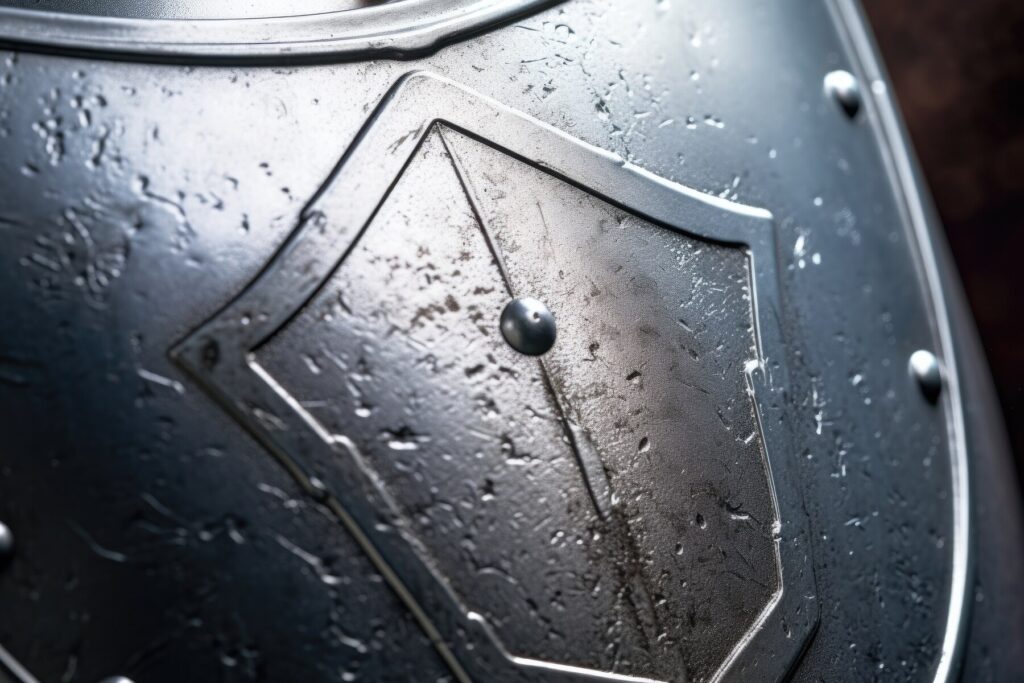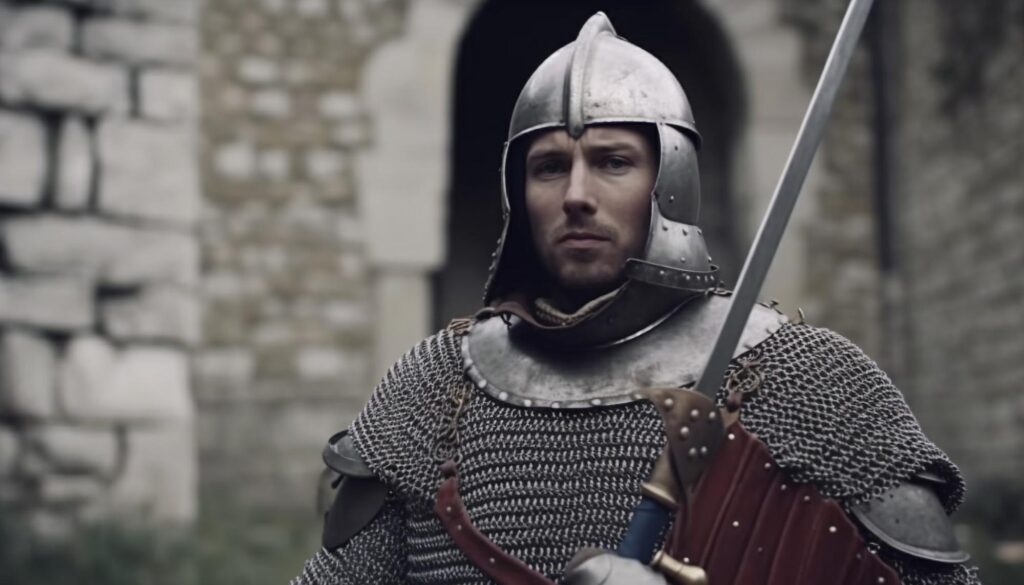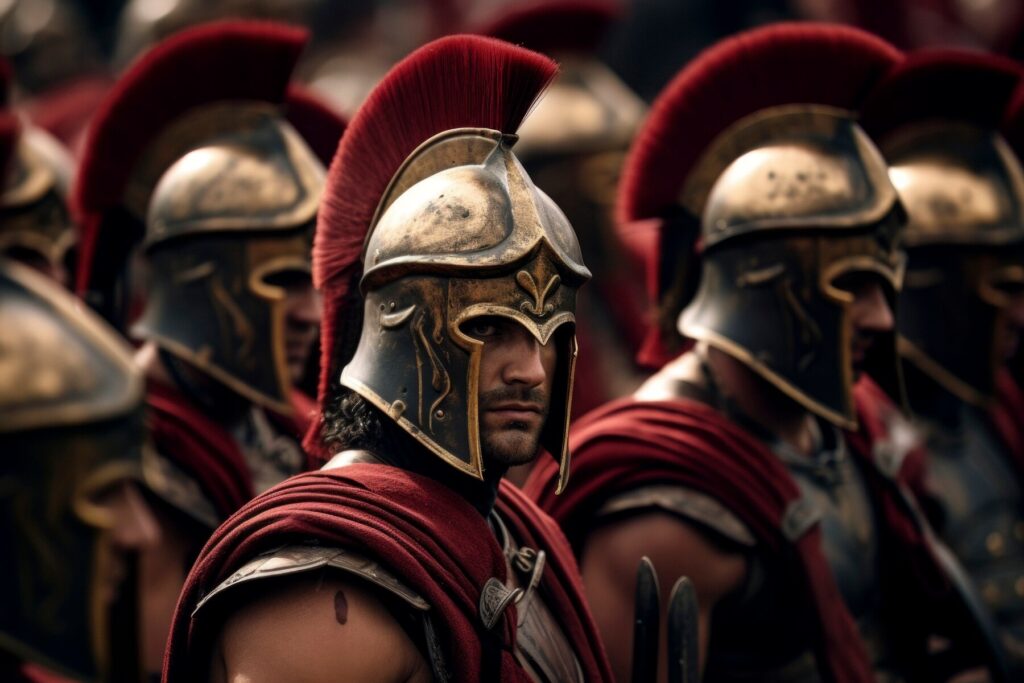Though Arthurian stories abound with battles and tournaments, factual descriptions of the arms and armor used are relatively rare. To a knightly audience, these would be thoroghly familiar and not need to be explained, except under special circumstances, such as to emphasize the richness of a champion’s armament.

Three such descriptions of the arming of a knight are of special interest: the arming of King Arthur at the eve of the battle of Badon, in Geoffrey of Monmouth’s Historia Regum Britanniae (ca. 1135); second, the arming of Erec in borrowed armor before the Joust of the Sparrowhawk, in Chrétien de Troyes’s Erec et Enide (ca. 1170); finally, the arming of Sir Gawain in Sir Gawain and the Green Knight (ca. 1400).
The arming of Erec and Gawain give accurate accounts of the armor used during the twelfth and fourteenth centuries; they also demonstrate the proper way a knight should be armed, namely from his feet upward, in order to avoid unnecessary tiring and top-heaviness. Erec’s armor consists of mail leggings (chausses) reinforced by separately buckled-on knee cops (genouillières) of solid plate, a mailshirt (hauberk), a helmet, and a shield. The term hauberk (from German Halsberge “neck cover”), and the detail that Enide fastens Erec’s aventail for him, indicate that this mailshirt had a hood (coif) with a face-covering flap, the aventail, and also mail mittens in one piece with its long sleeves, which made it impossible for Erec to tie the laces of the aventail himself. The helmet would have been a conical steel cap with a simple noseguard; the shield would be of the almond-shaped “Norman” type, with rounded top and drawn-out lower point covering the knight’s entire left side from eye to knee.
Gawain, on the other hand, is being armed in the much more complicated armor of mail (paunce, related to German Panzer) and plates developed in the second half of the fourteenth century: articulated iron shoes (sabatouns), shin defenses (greaves), knee cops (poleyns), and thigh defenses (cuishes). After these, he dons mailshirt (byrnie); emblazoned surcoat (cote-armure); and arm defenses of vambraces for the forearms, cowters for the elbows, rerebraces for the upper arms and pauldrons for the shoulders. The last items to be put on are the sword belt, the helmet, which now has an attached mail cape (camail and/or aventail) to replace the older coif; and finally the armored gloves (gauntlets).

It was understood that proper arming of a knight could be done only with the help of a squire (or an obliging damsel, as in Erec’s case). When the knight was in the saddle, his shield and lance would be handed to him by his squire (French écuyer ‘shield bearer’, from écu ‘shield’; German Schildknappe ‘shield boy’).
In striking contrast to these two descriptions, the arming of King Arthur in Geoffrey’s Historia is not done in contemporary arms but with
a leather jerking [lorica] worthy of so great a king. On his head… a golden helmet with a crest carved in the shape of a dragon; and across his shoulders a circular shield called Pridwen, on which was painted the likeness of the Blessed Mary, Mother of God.
These elements – leather lorica, dragon-crested helmet, circular shield – correspond to actual weapons found in the seventh-century ship burial of Sutton Hoo, now in the British Museum. The faithful preservation of these details over a period of at least 500 years is another clue that Geoffrey had access to some earlier source, quite possibly “a very ancient book in the British language”. High-ranking officers in the Late Roman army bore portraits of their emperors on their shields, as represented on the consular diptych of the commander-in-chief Stilicho (killed in A.D. 408); the icon of the Virgin Mary on Arthur’s shield was a logical alternative for a Christian commander without an emperor above him.
Geoffrey also states that, when the Romans withdrew from Britain (assumed date A.D. 410), they left behind samples of their armor and weapons as models for the Britons to copy for their self-defense. After almost four centuries of Roman occupation, the tribal military traditions of Britain had dwindled away. Former Roman magistrates became local chieftains, or even kings, and organized their followers as best as they could. The wealthier among them would have helmets (cassis or galea), and short-sleeved mailshirts (lorica hamata), but the shield (Latin scutum; Welsh ysquit) would have been the main defense for practically every fighting man, with the possible exception of archers, who needed both hands to draw their bows. Shields were made of half-inch-thick wooden boards, covered with glued-on leather against splitting under a heavy blow and reinforced around the rim with bronze or iron mountings. Circular or oval in shape, they had a central handgrip. To accommodate the holding hand, a hole was cut into the shield board, covered by the iron shield boss (umbo).
Spears, bows and arrows, and swords – the latter mostly longer (ca. three feet) versions of the Roman gladius – were the weapons of offense.
The King Arthur of legend is the leader of the knights of the Round Table; the “historical Arthur” is generally thought to have been a Romanized British war-leader, who revived half-forgotten Roman cavalry tactics in order to repel the hit-and-run raids of sea-borne Saxon pirates.

The last surviving muster roll of the Roman army, the Notitia Digitatum, of ca AD 425, shows that there was an unusual concentration of Roman cavalry in Britain. The only two active regiments of heavy-armored cavalry, cataphractarii, were stationed in Britain, one of them at Binchester/Vinovia. This was probably the Castell Guinnion in Nennius’s Battle List (ca. AD 800). In this list of Arthur’s twelve victories over the Saxons, most battle sites are at rivers, where pirate raids were to be expected, but three of them are places that were garrisons of Roman heavy cavalry. One of them, Bregomion, is proabably Ribchester/Bremetennacum, the settlment of the cuneus veteranorum Sarmatorum, the troop of Sarmatian veterans.
The Sarmatians were horse nomads from the eastern steppes; in AD 175 Emperor Marcus Aurelius had 5,500 of them transferred from Pannonia, today’s Hungary, to northern Britain to fight the Picts. They were the first heavy-armored cavalry known to western Europe, with body armor of horn or metal scales and similar armor for their horses. Their helmets were spangenhelms, built from bronze straps and iron filling plates. Their equipment was in fact the model for the cataphractarii of the Late Roman and Byzantine armies. They carried long lances (kontus) and long double-edged swords; the swords were often worn in pairs, one on either hip. Their battle standard was windsock-like dragon on a pole. And their tribal god of war was worshiped as a naked sword planted upright in the ground or a platform. The Sarmatians in Britain were attached as auxiliaries to the Sixth Legion; its praefectus was a certain Lucius Artorius Castus, who had served in Pannonia erlier in his career. It is thinkable that his name, like Caesar’s, became a title among the Sarmatian troopers. After 250 years in Britain, they were still referred to as the Sarmatian veterans, which indicates that they must have preserved their tribal identity reasonable intact. When the regular army withdrew from Britain, the Sarmatian veterans, who had been settled in Ribchester to guard the Lancashire coast against Irish pirates, seem to have stayed. They might have become the cavalry of the “historical Arthur,” when worse danger threatened from the Saxons.
Archaeological evidence for Roman-British arms is scarce. The Britons were Christians, who did not believe in warlike gravegoods as did the Saxons. The latter were pagans who could look forward to a warrior’s afterlife in Valhalla. The main defense of a Saxon thegn was a round shield, of basically the same construction as the British type, though Saxon shield could have an extra carrying sling for the forearm; they also could have sharply pointed bosses to be used as effective weapons in counterattack. Body armor consisted of mailshirts, produced in the formerly Roman industrial centers of the Rhinelands, and spangenhelms, the “barbarian” helmet type, introcuded into central Europe by eastern nomads, such as Sarmatians, Alani, and Huns. A particularly splendid type of spangenhelm seems to have been made at the court workshop of the Ostrogothic kings of Italy, at Ravenna, and distributed all over continental Europe, probably as diplomatic presents. Anglo-Saxon spangenhelms were distinguished by having crests, either dragon (Sutton Hoo helmet) or boar figurines (Benty Grange helmet); visor masks (grim) either covered the entire face or were frames around eyes and nose. However, not a single Germanic (or Viking) helmet with horns or wings has been found so far, though there are pre-Roman British and Gaulish horned helmets!
The name of the Saxons is derived from seax, a machete-like long-knife, both tool and weapon; its sword-length version was the scramasax (“wound-knife”). The name of the Angles is probably related to ango, a barbed throwing spear or harpoon. A much-favored weapon that also was a handy tool on shipboard was the battle-axe, which also gave name to a tribe of the continental Saxons, the Longobards (“Long-axes”). The Franks were feared for their short-handled throwing axes, the francisca.
The most treasured of weapons of a Germanic warrior was the sword (spatha); beautifully pattern-welded blades, whose surface markings evoked comparisons with dragon skin or twisting snakes, were produced in the Rhinelands, where mythical smiths, such as Wayland or Regin, to whom Siegfried once was apprenticed, were located, and where the cutlery center of Solingen still flourishes. Famous swords were given personal names; Balmung – Siegfried’s sword, Mimung and Nagelring – products of Wayland, Durendal – Roland’s sword, and of course Arthur’s Excalibur/Caliburnus. (The intricate cross-cultural relations of the Migration Period and the so-called Dark Ages are shown in these sword names: Balmung is probably related to Avalon, where Geoffrey has Arthur’s Caliburnus forged, whose name is derived from Latin chalybs ‘steel’, which in turn comes from the Kalybes, a Sarmatian tribe of smiths in the Caucasus.) To enhance the value of cherished sword, the maker richly mounted its hilt and scabbard in silver and gold. Ritual deposits of swords in sacred lakes are known from the province Angeln, the homeland of the Angles, at the Danish-German border. The motif of the Sword in the Lake might have its historical background in remembered occasions, when a priestess in charge of such a sacred lake would have retreived a sword for a champion, to be returned after the hero’s death.
See also
Coats of Arms | The Legend of King Arthur
Europe | The Legend of King Arthur
Round Tables | The Legend of King Arthur
Tournament Books | The Legend of King Arthur
Lady of the Lake | The Legend of King Arthur
Swords | Knighthood and Chivalry
